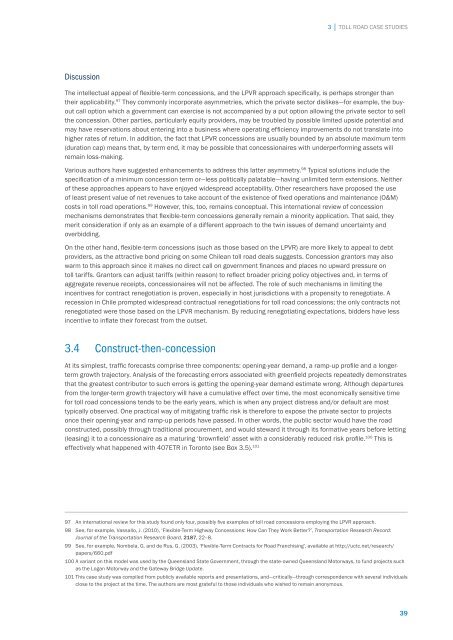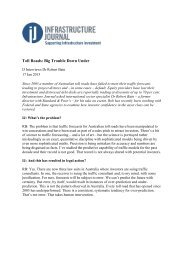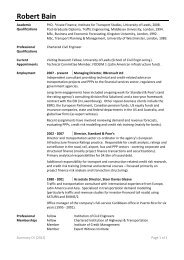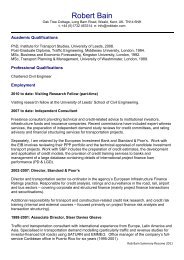Disincentivising overbidding for toll road concessions
Disincentivising overbidding for toll road concessions
Disincentivising overbidding for toll road concessions
- No tags were found...
You also want an ePaper? Increase the reach of your titles
YUMPU automatically turns print PDFs into web optimized ePapers that Google loves.
3 │ TOLL ROAD CASE STUDIES<br />
Discussion<br />
The intellectual appeal of flexible-term <strong>concessions</strong>, and the LPVR approach specifically, is perhaps stronger than<br />
their applicability. 97 They commonly incorporate asymmetries, which the private sector dislikes—<strong>for</strong> example, the buyout<br />
call option which a government can exercise is not accompanied by a put option allowing the private sector to sell<br />
the concession. Other parties, particularly equity providers, may be troubled by possible limited upside potential and<br />
may have reservations about entering into a business where operating efficiency improvements do not translate into<br />
higher rates of return. In addition, the fact that LPVR <strong>concessions</strong> are usually bounded by an absolute maximum term<br />
(duration cap) means that, by term end, it may be possible that concessionaires with underper<strong>for</strong>ming assets will<br />
remain loss-making.<br />
Various authors have suggested enhancements to address this latter asymmetry. 98 Typical solutions include the<br />
specification of a minimum concession term or—less politically palatable—having unlimited term extensions. Neither<br />
of these approaches appears to have enjoyed widespread acceptability. Other researchers have proposed the use<br />
of least present value of net revenues to take account of the existence of fixed operations and maintenance (O&M)<br />
costs in <strong>toll</strong> <strong>road</strong> operations. 99 However, this, too, remains conceptual. This international review of concession<br />
mechanisms demonstrates that flexible-term <strong>concessions</strong> generally remain a minority application. That said, they<br />
merit consideration if only as an example of a different approach to the twin issues of demand uncertainty and<br />
<strong>overbidding</strong>.<br />
On the other hand, flexible-term <strong>concessions</strong> (such as those based on the LPVR) are more likely to appeal to debt<br />
providers, as the attractive bond pricing on some Chilean <strong>toll</strong> <strong>road</strong> deals suggests. Concession grantors may also<br />
warm to this approach since it makes no direct call on government finances and places no upward pressure on<br />
<strong>toll</strong> tariffs. Grantors can adjust tariffs (within reason) to reflect b<strong>road</strong>er pricing policy objectives and, in terms of<br />
aggregate revenue receipts, concessionaires will not be affected. The role of such mechanisms in limiting the<br />
incentives <strong>for</strong> contract renegotiation is proven, especially in host jurisdictions with a propensity to renegotiate. A<br />
recession in Chile prompted widespread contractual renegotiations <strong>for</strong> <strong>toll</strong> <strong>road</strong> <strong>concessions</strong>; the only contracts not<br />
renegotiated were those based on the LPVR mechanism. By reducing renegotiating expectations, bidders have less<br />
incentive to inflate their <strong>for</strong>ecast from the outset.<br />
3.4 Construct-then-concession<br />
At its simplest, traffic <strong>for</strong>ecasts comprise three components: opening-year demand, a ramp-up profile and a longerterm<br />
growth trajectory. Analysis of the <strong>for</strong>ecasting errors associated with greenfield projects repeatedly demonstrates<br />
that the greatest contributor to such errors is getting the opening-year demand estimate wrong. Although departures<br />
from the longer-term growth trajectory will have a cumulative effect over time, the most economically sensitive time<br />
<strong>for</strong> <strong>toll</strong> <strong>road</strong> <strong>concessions</strong> tends to be the early years, which is when any project distress and/or default are most<br />
typically observed. One practical way of mitigating traffic risk is there<strong>for</strong>e to expose the private sector to projects<br />
once their opening-year and ramp-up periods have passed. In other words, the public sector would have the <strong>road</strong><br />
constructed, possibly through traditional procurement, and would steward it through its <strong>for</strong>mative years be<strong>for</strong>e letting<br />
(leasing) it to a concessionaire as a maturing ‘brownfield’ asset with a considerably reduced risk profile. 100 This is<br />
effectively what happened with 407ETR in Toronto (see Box 3.5). 101<br />
97 An international review <strong>for</strong> this study found only four, possibly five examples of <strong>toll</strong> <strong>road</strong> <strong>concessions</strong> employing the LPVR approach.<br />
98 See, <strong>for</strong> example, Vassallo, J. (2010), ‘Flexible-Term Highway Concessions: How Can They Work Better’, Transportation Research Record:<br />
Journal of the Transportation Research Board, 2187, 22–8.<br />
99 See, <strong>for</strong> example, Nombela, G. and de Rus, G. (2003), ‘Flexible-Term Contracts <strong>for</strong> Road Franchising’, available at http://uctc.net/research/<br />
papers/660.pdf<br />
100 A variant on this model was used by the Queensland State Government, through the state-owned Queensland Motorways, to fund projects such<br />
as the Logan Motorway and the Gateway Bridge Update.<br />
101 This case study was compiled from publicly available reports and presentations, and—critically—through correspondence with several individuals<br />
close to the project at the time. The authors are most grateful to those individuals who wished to remain anonymous.<br />
39






